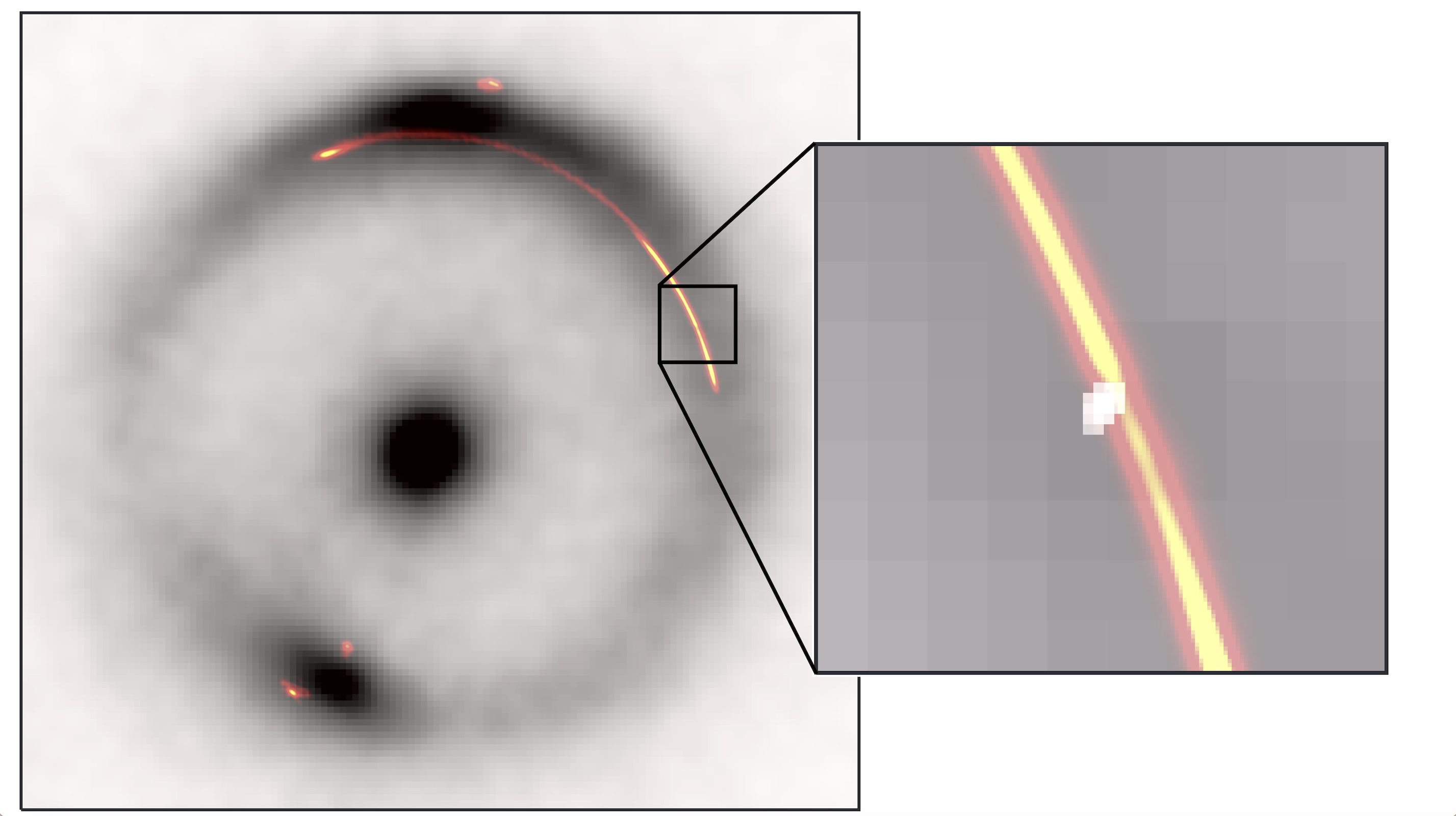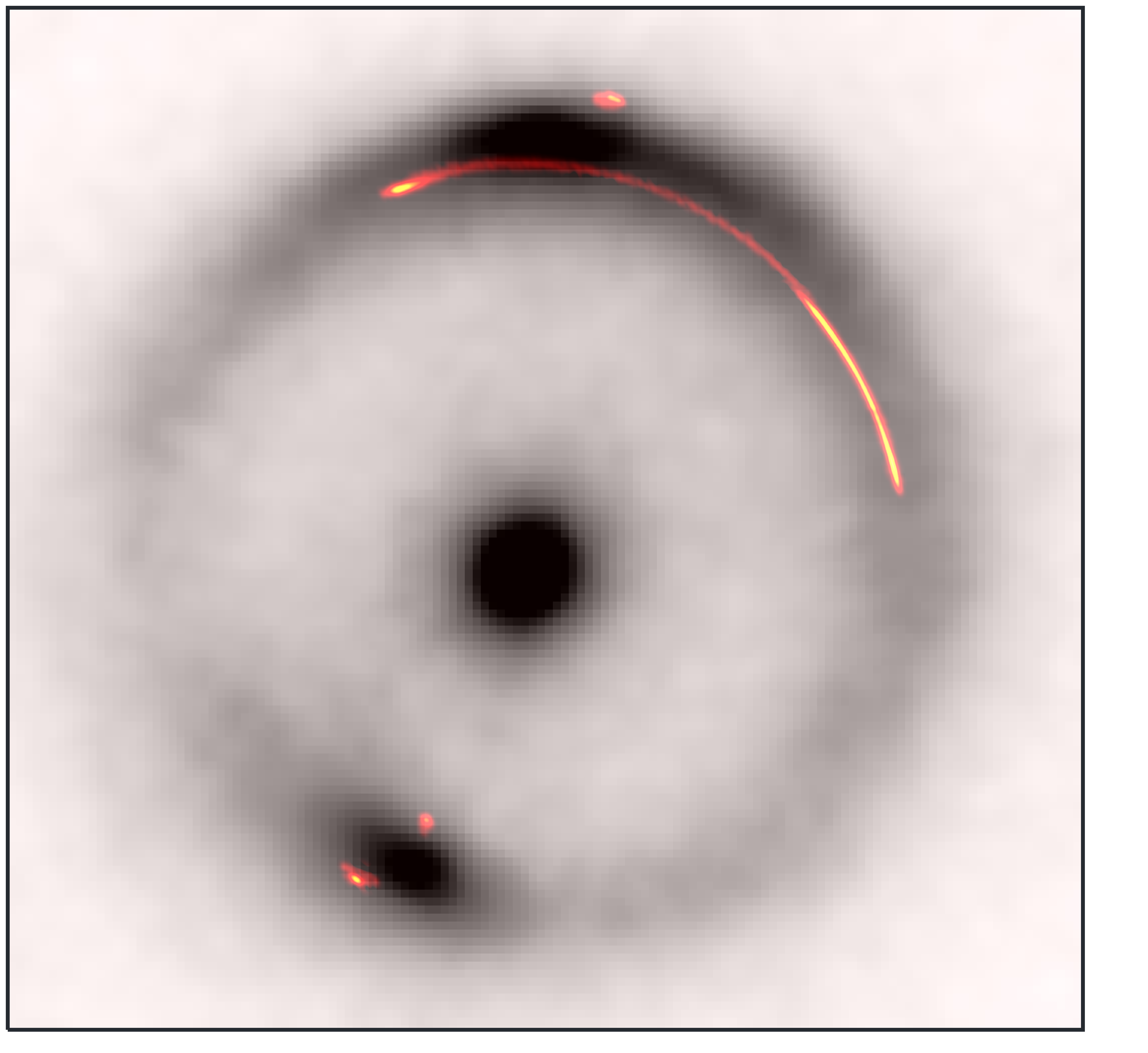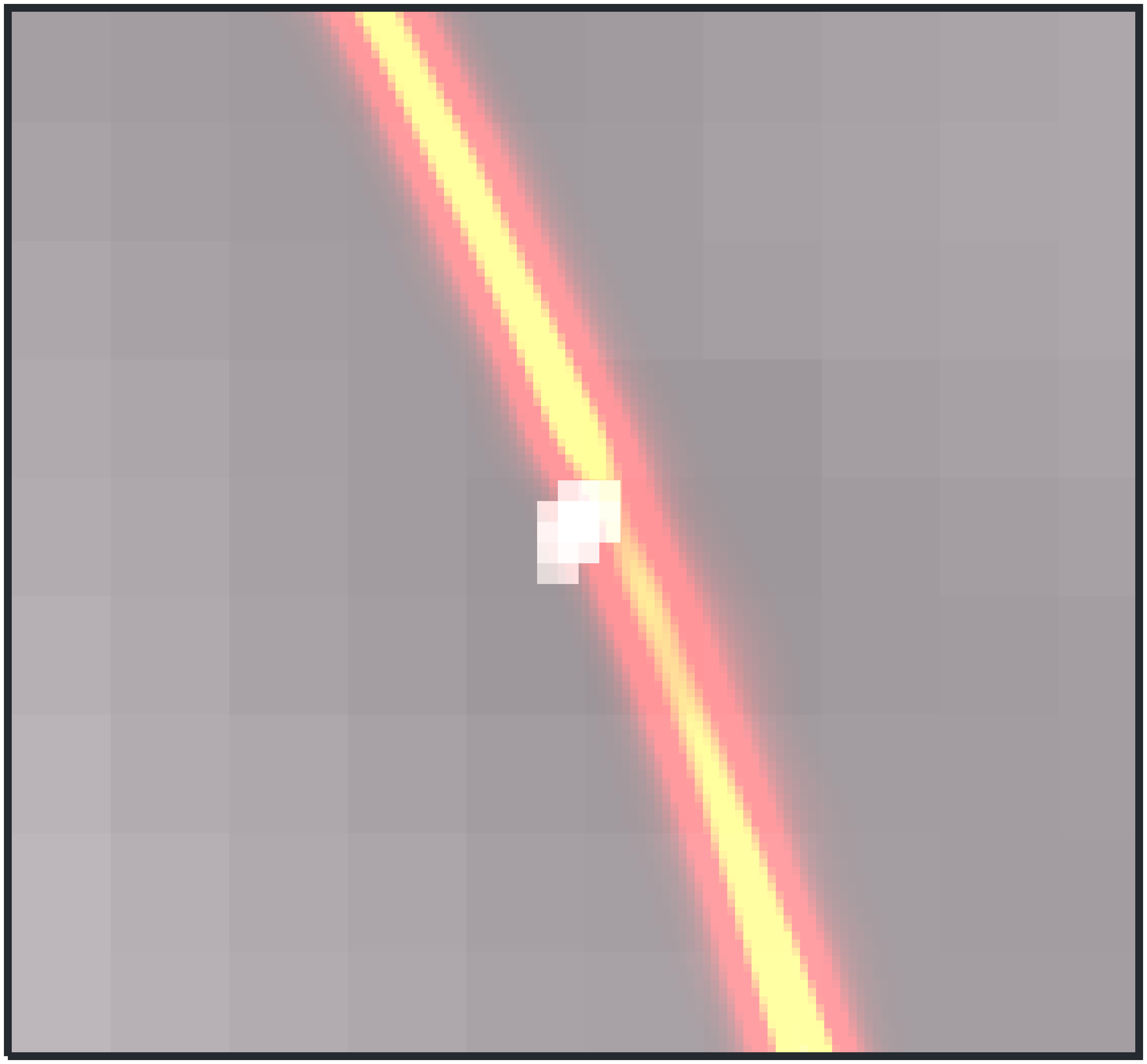
Overlay of the infrared emission (black and white) with the radio emission (colour). The dark, low-mass object is located at the gap in the bright part of the arc on the right-hand side, but is not luminous at infrared or radio wavelengths. The zoom in shows the pinch in the luminous radio arc, where the extra mass from the dark object is gravitationally ‘imaged’ using the sophisticated modelling algorithms of the team. The dark object is indicated by the white blob at the pinch point of the arc, but no light from it has so far been detected at optical, infrared or radio wavelengths. Image credit: Keck/EVN/GBT/VLBA
An international team of astronomers has found a low mass dark object in the distant Universe, not by directly observing any emitted light, but by detecting its tiny gravitational distortion of the light from another distant galaxy. This required combining data from radio telescopes distributed all over the world at the Joint Institute for VLBI ERIC (JIVE). The mysterious object has a mass of about one million times that of our Sun, and its discovery seems consistent with the current best theory about how galaxies like our own Milky Way formed. The results are described in two articles published in Nature Astronomy and the Monthly Notices of the Royal Astronomical Society.
“Hunting for dark objects that don't seem to emit any light is clearly challenging”, said Dr. Devon Powell at the Max Planck Institute for Astrophysics (MPA) and lead author of the study published in Nature Astronomy. “Since we can’t see them directly, we instead use very distant galaxies as a backlight to look for their gravitational imprints.”
Dark matter is an enigmatic form of matter not expected to emit light, yet it is essential to understanding how the rich tapestry of stars and galaxies we see in the night sky evolved. As a fundamental building block of the universe, a key question for astronomers is whether dark matter is smooth or clumpy, as this could reveal what it is made of. As dark matter cannot be seen, its properties can only be determined by observing the gravitational lensing effect, whereby the light from a more distant object is distorted and deflected by the gravity of the dark object.
A telescope the size of the Earth
The team used a network of telescopes from around the world, including the Green Bank Telescope (GBT), the Very Long Baseline Array (VLBA) and the European Very Long Baseline Interferometric Network (EVN). The data from this international network were correlated at the Joint Institute for VLBI ERIC (JIVE) in the Netherlands, forming an Earth-sized super-telescope that could capture the subtle signals of gravitational lensing by the dark object. They discovered that the object has a mass a million times greater than that of our Sun and is located in a distant region of space, approximately 10 billion light years from Earth, when the universe was only 6.5 billion years old.
This is the lowest mass object to be found using this technique, by a factor of about 100. To achieve this level of sensitivity, the team had to create a high-fidelity image of the sky using radio telescopes located around the world. Professor John McKean from the University of Groningen (RuG), the University of Pretoria (UP) and the South African Radio Astronomy Observatory (SARAO), who led the data collection and is the lead author of a companion paper, said: “From the first high-resolution image, we immediately saw a pinch in the gravitational arc, which is the tell-tale sign that we were onto something. Only another small clump of mass between us and the distant radio galaxy could cause this.”
To analyse the massive dataset, the team had to develop new modelling algorithms that could only be run on supercomputers. “The data are so large and complex that we had to develop new numerical approaches to model them. This was not straightforward as it had never been done before”, said Dr Simona Vegetti at MPA. “We expect every galaxy, including our own Milky Way, to be filled with dark matter clumps, but finding them and convincing the community that they exist requires a great deal of number crunching”, she continued. The team applied a special technique called gravitational imaging, which allowed them to ‘see’ the invisible dark matter clump by mapping its gravitational lensing effect against the radio-luminous arc.
More dark objects
“Given the sensitivity of our data, we were expecting to find at least one dark object, so our discovery is consistent with the so-called ‘cold dark matter theory’ on which much of our understanding of how galaxies form is based”, said Powell. “Having found one, the question now is whether we can find more and whether their number and their internal structure will still agree with the models.”
The team are now analysing the data further to better understand what the mysterious dark object could be, but they are also looking into other parts of the sky to see if they can find more examples of such low-mass dark objects using the same technique. If they continue to find such mysterious objects in other parts of the universe, and if they really turn out to be completely devoid of stars, then some theories of dark matter may be ruled out.

Overlay of the infrared emission (black and white) with the radio emission (colour). The dark, low-mass object is located at the gap in the bright part of the arc on the right-hand side. Image credit: Keck/EVN/GBT/VLBA

The zoom in shows the pinch in the luminous radio arc, where the extra mass from the dark object is gravitationally ‘imaged’ using the sophisticated modelling algorithms of the team. The dark object is indicated by the white blob at the pinch point of the arc, but no light from it has so far been detected at optical, infrared or radio wavelengths. Image credit: Keck/EVN/GBT/VLBA
Additional information
Gravitational lensing: This is an astrophysical tool used by astronomers to measure the mass properties of structure in the Universe. It is a consequence of Einstein’s Theory of General Relativity, where mass in the Universe curves space. If the mass of the foreground lensing object (typically a galaxy or cluster of galaxies) is sufficiently dense, then the light from distant objects is distorted and multiple images are even seen. In the case of this system, called B1938+666, the foreground infrared luminous galaxy (seen at the centre of the ring), results in a beautiful Einstein ring of the distant galaxy. However, the distant galaxy is also bright at radio wavelengths, showing the beautiful multiple images and gravitational arcs (seen in red).
Very Long Baseline Interferometry: The radio observations were taken using a combination of radio telescopes that are combined to form a so-called Very Long Baseline Interferometer. This observational method allows astronomers to improve the imaging sharpness of the data and reveal very small fluctuations in the brightness that otherwise could not be seen. For example, the resolving power of the VLBI data is a factor 13 better than the infrared imaging from the W. M. Keck Telescope adaptive optics system (also shown in the figures in black and white). The telescopes used in the observations were the Green Bank Telescope and the Very Long Baseline Array of the National Radio Astronomy Observatory in the United States, and the telescopes of the European Very Long Baseline Interferometric Network.
Gravitational imaging: This is a novel method astronomers use to ‘see’ mass in the Universe even though it does not emit any light. This method uses the extended gravitational arcs to look for small aberrations that can only be caused by an additional, invisible component of mass. By combining this method and the exquisite high angular resolution imaging from the VLBI data, the team were able to detect the presence of the lowest mass dark object currently measured.
Paper links
Powell et al. https://www.nature.com/articles/s41550-025-02651-2
McKean et al. https://doi.org/10.1093/mnrasl/slaf039
Contacts
Prof. John McKean, University of Groningen, University of Pretoria, and South African Radio Astronomy Observatory: john.mckean@up.ac.za
Dr. Devon Powell, Max Planck Institute for Astrophysics: dmpowell@mpa-garching.mpg.de
Dr. Simona Vegetti, Max Planck Institute for Astrophysics: svegetti@mpa-garching.mpg.de
JIVE contact
Ioanna Kazakou, JIVE communications officer: kazakou@jive.eu
About JIVE and the EVN
The Joint Institute for VLBI ERIC (JIVE) has as its primary mission to operate and develop the European VLBI Network data processor, a powerful supercomputer that combines the signals from radio telescopes located across the planet. Founded in 1993, JIVE is since 2015 a European Research Infrastructure Consortium (ERIC) with seven member countries: France, Italy, Latvia, the Netherlands, United Kingdom, Spain and Sweden; additional support is received from partner institutes in China, Germany and South Africa. JIVE is hosted at the offices of the Netherlands Institute for Radio Astronomy (ASTRON) in the Netherlands.
The European VLBI Network (EVN) is an interferometric array of radio telescopes spread throughout Europe, Asia, and South Africa that conducts unique, high-resolution, radio astronomical observations of cosmic radio sources. Established in 1980, the EVN has grown into the most sensitive VLBI array in the world, including over 20 individual telescopes, among them some of the world's largest and most sensitive radio telescopes. The EVN is composed of 13 Full Member Institutes and 5 Associated Member Institutes.
